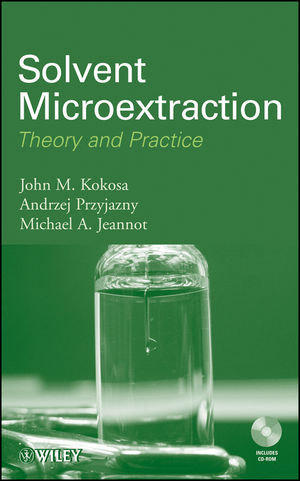Solvent Microextraction: Theory and PracticeISBN: 978-0-470-27859-8
Hardcover
344 pages
October 2009
 |
||||||
1 SOLVENT MICROEXTRACTION: COMPARISON WITH OTHER POPULAR SAMPLE PREPARATION METHODS.
1.1 Introduction.
1.2 Comparison of Sample Preparation Methods.
1.3 Summary.
References.
2 BASIC MODES OF OPERATION FOR SOLVENT MICROEXTRACTION.
2.1 Basic Principles of SME.
2.2 Extraction Modes.
2.3 Solvents.
3 THEORY OF SOLVENT MICROEXTRACTION.
3.1 Introduction.
3.2 Thermodynamics.
3.3 Kinetics.
3.4 Calibration Methods.
3.5 Summary.
References.
4 PRACTICAL CONSIDERATIONS FOR USING SOLVENT MICROEXTRACTION.
4.1 Introduction.
4.2 General Recommendations.
4.3 General Questions to Consider Before Performing an Analysis.
4.4 Choosing the SME Mode.
4.5 Extraction Solvent.
4.6 Sample Volumes.
4.7 Syringe and Microdrop.
4.8 Chromatography and Detector Requirements.
4.9 Additional Extraction Parameters.
4.10 Calculation Examples for SDME.
4.11 Calculation Examples for DLLME and HFME.
4.12 Calculation Examples for the Effect of Ionic Strength on SDME.
4.13 Calculation Examples for HS-SDME.
4.14 Calculation Examples for the Effect of Ionic Strength on HS-SDME.
4.15 Calculation Examples for Static Headspace Extraction.
4.16 Calculation Examples for Solvent Solubility.
References.
5 METHOD DEVELOPMENT IN SOLVENT MICROEXTRACTION.
5.1 Introduction.
5.2 Extraction Mode Selection.
5.3 Static vs. Dynamic Extraction.
5.4 Selection of Manual vs. Automated Extraction.
5.5 Selection of Direct vs. Derivatization SME.
5.6 Extraction Solvent Selection.
5.7 Selection of Final Determination Method.
5.8 Selection of Extraction Optimization Method.
5.9 Optimization of Extraction Conditions.
References.
6 APPLICATIONS.
6.1 Introduction.
6.2 Gaseous Samples.
6.3 Liquid Samples.
6.4 Solid Samples.
6.5 Environmental Applications of SME.
6.6 Clinical and Forensic Applications of SME.
6.7 Application of SME in Food and Beverage Analysis.
6.8 Application of SME in the Analysis of Plant Material.
6.9 Application of SME in the Analysis of Consumer Products and Pharmaceuticals.
6.10 Outlook for Future Analytical Applications of SME.
6.11 Physicochemical Applications of SME.
References.
7 SME EXPERIMENTS.
7.1 Introduction.
7.2 Recommended Experimental Conditions.
7.3 Determination of Gasoline Diluents in Motor Oil by HS-SDME.
7.4 Determination of BTEX in Water by HS-SDME.
7.5 Analysis of Halogenated Disinfection By-Products by SDME and HS-SDME.
7.6 Analysis of Volatile Organic Compounds by SDME and HS-SDME.
7.7 Analysis of Residual Solvents in Drug Products by HS-SDME.
7.8 Arson Accelerant Analyses by HS-SDME.
7.9 Analysis of PAHs by SDME.
7.10 Determination of Acetone in Aqueous Solutions by Derivatization HS-SDME.
7.11 Determination of Pesticides in Soil by HF(2)ME.
7.12 Determination of PAHs and HOCs by DLLME.
7.13 Dynamic Headspace and Direct Immersion Extractions (DY-SME).
References.
ACRONYMS AND ABBREVIATIONS.
APPENDIX SME MODES: CLASSIFICATION AND GLOSSARY.
INDEX.



